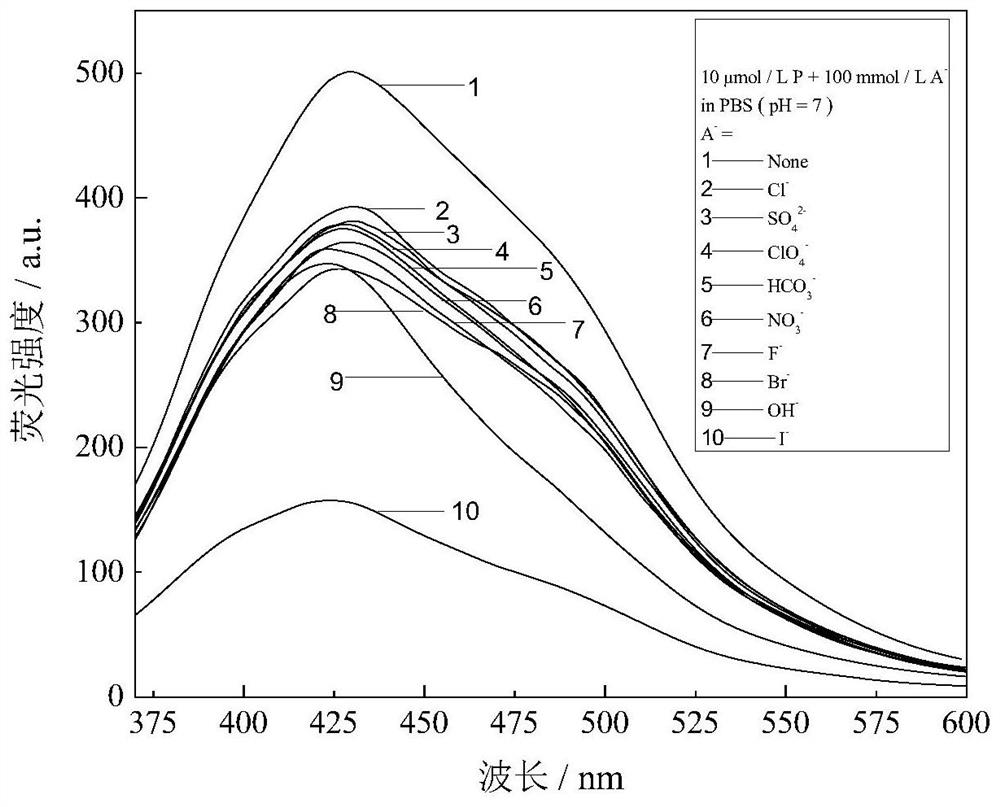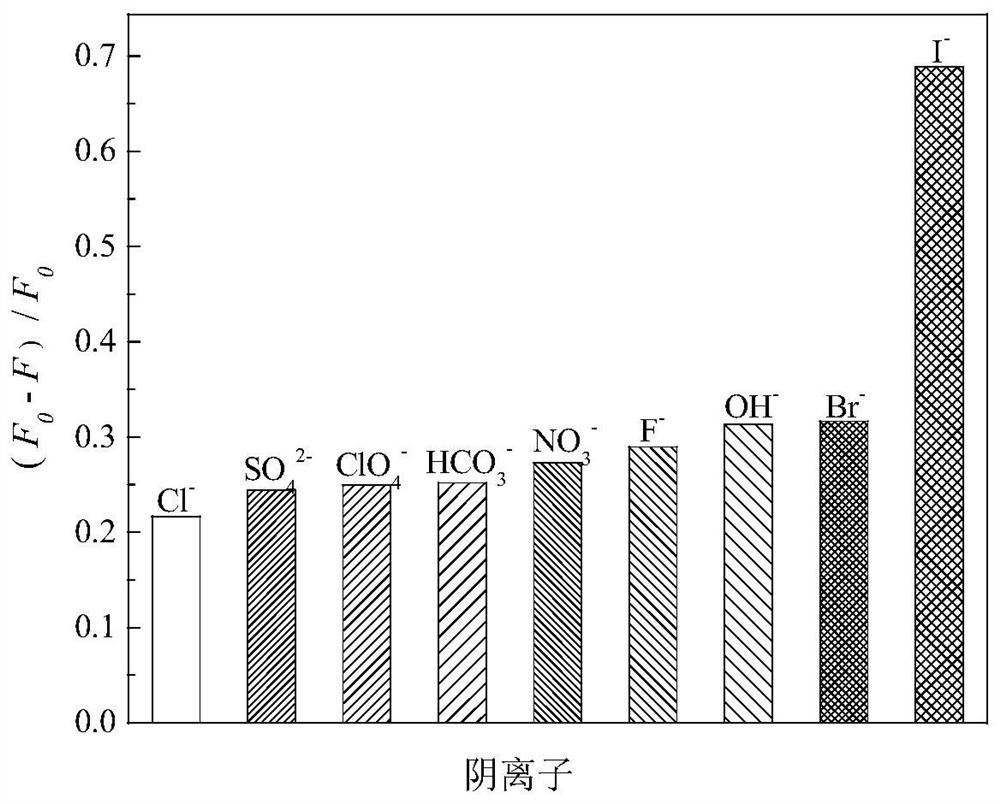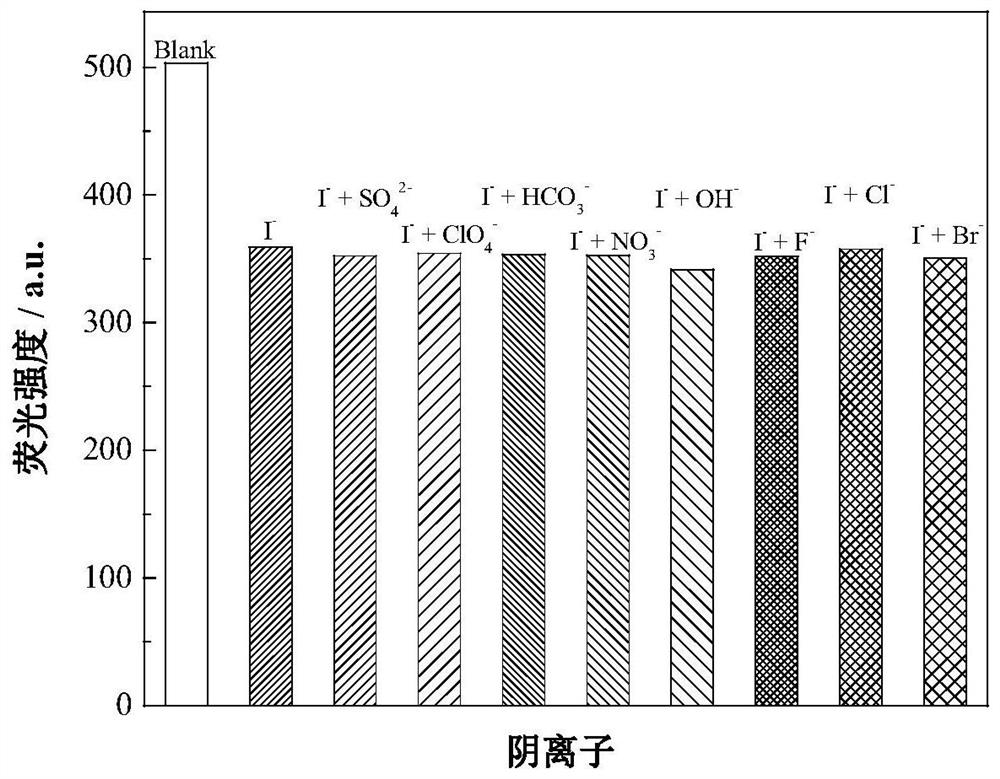A kind of iodide ion recognition probe and preparation method thereof
An iodide ion and probe technology, applied in the field of analysis and detection, can solve the problems of expensive instruments and equipment, complicated procedures, and many steps, and achieve the effects of strong anti-interference ability, high detection selectivity and simple synthesis method.
- Summary
- Abstract
- Description
- Claims
- Application Information
AI Technical Summary
Problems solved by technology
Method used
Image
Examples
preparation example Construction
[0031] A kind of preparation method of the probe of above-mentioned recognition iodide ion, its synthesis technical route is as follows:
[0032] first step:
[0033]
[0034] Step two:
[0035]
[0036] The specific method is as follows:
[0037] The first step: the method uses (9,9-bis(6-bromohexyl)-2,7-difluorenaldehyde) as a raw material, and reacts with 2,5-diaminopyridine under the condition of anhydrous LiCl as a catalyst, The intermediate product II is obtained.
[0038] In some embodiments: the molar ratio of 2,5-diaminopyridine to compound I in the first step reaction is 1:1~1:3, the temperature of the first step reaction needs to reach 100~120°C under nitrogen protection, the second step The one-step reaction time is 8 to 24 hours.
[0039] The second step: under the condition of N,N-dimethylacetamide (DMAc) as solvent, intermediate product II and trimethylamine (NMe 3 ) reaction to obtain polymer P.
[0040] In some embodiments: the second step reaction...
Embodiment 1
[0043] Preparation and characterization of iodide ion recognition probe P:
[0044] Take 0.02667g of 9,9-bis(6-bromohexyl)-2,7-difluorenaldehyde as raw material, and 0.0159g (0.15mmoL) 2,5-diaminopyridine in excess of 3 times, measure 25mL of DMF ( Remove water) into the reaction eggplant bottle, add 0.5g (0.0118moL) catalyst anhydrous LiCl, place in an oil bath under the protection of nitrogen and heat to 110 ° C for 12 hours. After the reaction was completed, the reactant was slowly added dropwise to 500 mL of ice-water mixture to make it settle, and then the precipitate was centrifuged, washed with deionized water until the supernatant was clear, and freeze-dried. 0.0204 g of the intermediate product II was obtained as a brown powder, and the yield was 48%.
[0045] Take 0.02g (32.2μmoL) of the above-mentioned intermediate product II in a 100mL eggplant-shaped bottle, then measure 15mL DMAc, then add 15mL 30% trimethylamine aqueous solution, seal the device, stir and react...
Embodiment 2
[0051] Fluorescence recognition and detection of iodide ion by probe P:
[0052] Such as figure 1 As shown, in the PBS (pH=7) buffer solution system of 10 μmol / L probe molecule P, add anion solution (SO 4 2- , ClO 4 - 、HCO 3 - , OH - , F - , Cl - 、Br - , I - ) to make its concentration reach 100mmol / L, and the fluorescence experiment was measured on a fluorescence spectrophotometer of model LS55 produced by PE Company in the United States. From the figure, we can find that different anions can cause different degrees of fluorescence quenching of probe P, among which iodide ion is the most significant. This phenomenon indicates that the probe molecule P has a unique response to iodide ions.
[0053] Such as figure 2 As shown, the fluorescence quenching efficiency is calculated when the anion concentration is 100mmol / L. It can be seen from the figure that different anions can cause the fluorescence of the probe molecule P to be quenched to varying degrees, but addi...
PUM
 Login to View More
Login to View More Abstract
Description
Claims
Application Information
 Login to View More
Login to View More - R&D
- Intellectual Property
- Life Sciences
- Materials
- Tech Scout
- Unparalleled Data Quality
- Higher Quality Content
- 60% Fewer Hallucinations
Browse by: Latest US Patents, China's latest patents, Technical Efficacy Thesaurus, Application Domain, Technology Topic, Popular Technical Reports.
© 2025 PatSnap. All rights reserved.Legal|Privacy policy|Modern Slavery Act Transparency Statement|Sitemap|About US| Contact US: help@patsnap.com



